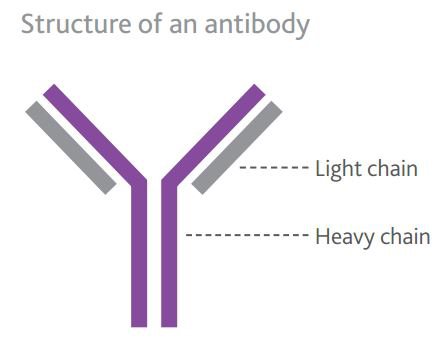What is myeloma?
Myeloma affects white blood cells called plasma cells. Plasma cells are made inside your bone marrow, the spongy material inside some of your bones.
Myeloma, plasma cells and antibodies
The role of plasma cells is to make antibodies. These are proteins that circulate in your blood, finding and killing germs such as viruses, bacteria and fungus which cause infections.
In myeloma, something goes wrong with your plasma cells. They start making antibodies that don’t work properly and can’t kill germs effectively. So you may have infections that last longer and are more frequent than usual.
These abnormal plasma cells – or myeloma cells – also grow more quickly than they should. They crowd your bone marrow so there isn’t enough room for other blood cells to be made. This leads to other symptoms of myeloma, such as anaemia, which can make you feel tired.

Order your free guide to myeloma
Includes myeloma treatments, living well with myeloma and questions to ask your medical team.
Myeloma and paraproteins
Antibodies are complex Y-shaped proteins, made up of chemical structures called heavy chains and light chains. You may also hear them called immunoglobulins.
The abnormal antibodies produced by myeloma cells are known as paraproteins. They are sometimes called other names like M-protein, M-band or M-spike – these terms all mean the same thing. If there is paraprotein in your blood, it may be a sign that you have myeloma.
Most people with a diagnosis of myeloma will have regular blood tests to monitor the level of paraprotein in their blood. But in some types of myeloma, the myeloma cells don’t produce paraprotein. So it will be monitored in other ways.

Antibodies are Y-shaped proteins that help us fight off infection. They are made up of structures called heavy chains and light chains.
Myeloma types
There are different types of myeloma which can be identified by diagnostic tests. The type of myeloma you have depends on the type of paraprotein and light chains in your blood.
Myeloma cells make only one type of paraprotein, and this varies from person to person. There are five types of paraprotein: G, A, D, E and M. IgG (immunoglobulin G) is the most common type, IgA less common. The others are very rare.
There are two types of light chains: kappa and lambda.
Based on this, you may be told that you have, for instance, IgG kappa myeloma.
After genetic tests, you may also be told that you have a particular genetic subtype of myeloma. This information gives doctors a better idea of how the myeloma might progress (your prognosis). In future, we hope there will be targeted treatments for different genetic subtypes of myeloma.
"Don’t feel you have to learn all the terminology on day one – it’s natural to feel confused at first but you will get the hang of it."
Ian, living with myeloma since 2019
Read about how people like Ian are coping with a myeloma diagnosis.

What is smouldering myeloma?
Myeloma can be smouldering or active.
People with smouldering myeloma don’t have any symptoms of myeloma. They are often diagnosed by chance following a blood test for something else.
Smouldering myeloma is also called asymptomatic myeloma because of the lack of symptoms.
- If you have active myeloma, you will usually have some symptoms and will normally start treatment quite quickly.
- If you have smouldering myeloma, you may not need treatment for a while, or perhaps never. You will be monitored regularly until your doctor recommends you start treatment. This approach is called active monitoring or watch and wait.
What is light chain myeloma?
One in five people with myeloma (20%) have light chain myeloma. In light chain myeloma, the myeloma cells don’t produce whole paraproteins, just the light chain parts. Regular tests will monitor the level of light chains in the blood, and sometimes in the urine.
If you have light chain myeloma, you may be told you have either kappa or lambda light chain myeloma.
Find out more about tests for myeloma.
What is non-secretory myeloma?
Around three people in a hundred with myeloma (3%) have non-secretory myeloma. In this type of myeloma, the myeloma cells don’t produce any paraprotein or light chains.
Sometimes, the myeloma cells produce a very small amount of paraprotein or light chains. This is known as oligo-secretory myeloma.
Non-secretory and oligo-secretory myeloma are hard to detect using blood tests. That’s why doctors and research scientists sometimes describe these types of myeloma as “non-measurable” myeloma. Tests may look normal, or almost normal, although there may be other changes seen in the blood.
If this is the case for you, then blood and urine tests may not be enough to check on your condition, so your doctor will monitor you using bone marrow samples and scans.
Multiple myeloma
Myeloma is often referred to as multiple myeloma because it affects the bone marrow in more than one place and can affect other parts of the body.
Multiple myeloma and myeloma are different names for the same disease.

Information for the Black community
Get essential information about blood cancer including stories from Black people with blood cancer and where to find support.
Causes of myeloma
We don’t fully understand what causes myeloma, but we know that there are some things that make it more likely to develop myeloma. These are called risk factors.
The main risk factors for myeloma are:
The chance of developing myeloma rises as you get older. Over nine in ten (90%) of people diagnosed with myeloma are over 50. Myeloma doesn’t affect children.
Men are more likely than women to develop myeloma – we don’t know why. In the UK, on average, seven out of every ten people with myeloma (70%) will be men.
If you have a close relative (such as a parent or sibling) with myeloma, you are more likely to develop myeloma than someone who doesn’t have a family history of myeloma. However, myeloma is a rare disease and the risk for everyone is still low.
People of African-Caribbean origin are more likely to get myeloma than white people. White people are more likely to get it than people from an Asian background. We don’t yet know why.
Read more about experiences of blood cancer in the Black community.
People with a condition called monoclonal gammopathy of undetermined significance, or MGUS (pronounced em-gus) have a higher risk of developing myeloma – around one in a hundred people with MGUS (1%) go on to develop myeloma each year.
We have more information about MGUS.

I've just been told I have blood cancer
Find answers about what happens next and coping with emotions and everyday life.
